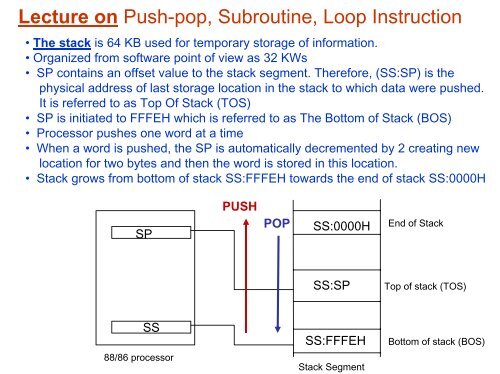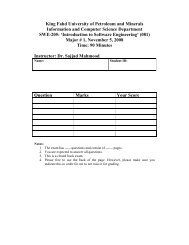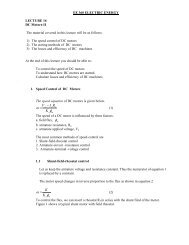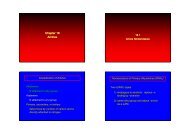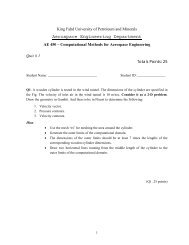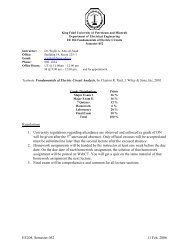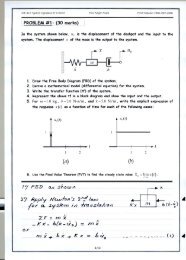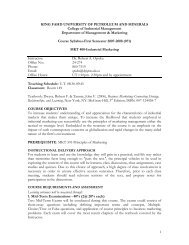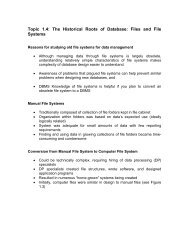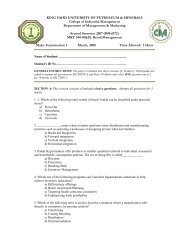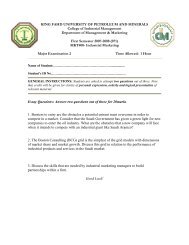Lecture on Push-pop, Subroutine, Loop Instruction - KFUPM Open ...
Lecture on Push-pop, Subroutine, Loop Instruction - KFUPM Open ...
Lecture on Push-pop, Subroutine, Loop Instruction - KFUPM Open ...
Create successful ePaper yourself
Turn your PDF publications into a flip-book with our unique Google optimized e-Paper software.
<str<strong>on</strong>g>Lecture</str<strong>on</strong>g> <strong>on</strong> <strong>Push</strong>-<strong>pop</strong>, <strong>Subroutine</strong>, <strong>Loop</strong> Instructi<strong>on</strong><br />
• The stack is 64 KB used for temporary storage of informati<strong>on</strong>.<br />
• Organized from software point of view as 32 KWs<br />
• SP c<strong>on</strong>tains an offset value to the stack segment. Therefore, (SS:SP) is the<br />
physical address of last storage locati<strong>on</strong> in the stack to which data were pushed.<br />
It is referred to as Top Of Stack (TOS)<br />
• SP is initiated to FFFEH which is referred to as The Bottom of Stack (BOS)<br />
• Processor pushes <strong>on</strong>e word at a time<br />
• When a word is pushed, the SP is automatically decremented by 2 creating new<br />
locati<strong>on</strong> for two bytes and then the word is stored in this locati<strong>on</strong>.<br />
• Stack grows from bottom of stack SS:FFFEH towards the end of stack SS:0000H<br />
SP<br />
SS<br />
88/86 processor<br />
PUSH<br />
POP<br />
SS:0000H<br />
SS:SP<br />
SS:FFFEH<br />
Stack Segment<br />
End of Stack<br />
Top of stack (TOS)<br />
Bottom of stack (BOS)
PUSH and POP Instructi<strong>on</strong>s<br />
The stack is used as temporary storage of registers and memory locati<strong>on</strong>s<br />
PUSH is used to store data and POP is used to retrieve it back from the stack<br />
Mnem<strong>on</strong>ic Meaning Format Operati<strong>on</strong> Flags Affected<br />
PUSH<br />
POP<br />
<strong>Push</strong> word <strong>on</strong>to stack<br />
Pop word off stack<br />
PUSH S<br />
POP D<br />
Operand (S or D)<br />
Register<br />
Seg-rcg (CS illegal)<br />
Memory<br />
((SP)) (S)<br />
(SP) (SP)-2<br />
(D) ((SP))<br />
(SP) (SP)+2<br />
Allowed operands for PUSH and POP instructi<strong>on</strong>s<br />
N<strong>on</strong>e<br />
N<strong>on</strong>e
Example for PUSH<br />
Given<br />
SS=0105h<br />
SP=0008h<br />
AX=1234h<br />
What is the outcome of the instructi<strong>on</strong> PUSH AX<br />
BOS = 01050+FFFEh=1104h<br />
TOS=01050+0008h=1058H<br />
Decrement the SP by 2 and write AX into the word locati<strong>on</strong> 1056h.<br />
SS:0006 1056h AL<br />
SS:0007 1057h AH<br />
SS:0008 1058h<br />
34h<br />
12h<br />
NOT USED<br />
SP<br />
00h 06h
What is the outcome of the following instructi<strong>on</strong>s<br />
POP AX<br />
POP BX<br />
If originally (SS:SP)=1056H<br />
Read into the specified register from the stack and increment the<br />
stack pointer for each POP operati<strong>on</strong><br />
At the first POP<br />
(AX) = 1234h (SS:SP) = 1058h<br />
At the sec<strong>on</strong>d POP<br />
(BX) = AABBh and (SS:SP) =105AH<br />
1056 34<br />
1057 12<br />
1058 BB<br />
1059 AA
<strong>Push</strong> and Pop Instructi<strong>on</strong>s<br />
Saved parameters must be retrieved in the reverse order<br />
(First PUSHed, Last POPed)<br />
To save registers and<br />
parameters <strong>on</strong> the stack<br />
Main body of the<br />
subroutine<br />
To restore registers and<br />
parameters from the stack<br />
Return to main program<br />
PUSH XX<br />
PUSH YY<br />
PUSH ZZ<br />
.<br />
.<br />
.<br />
.<br />
.<br />
POP ZZ<br />
POP YY<br />
POP XX<br />
RET
<strong>Subroutine</strong>s and <strong>Subroutine</strong> Handling Functi<strong>on</strong>s<br />
• A subroutine is a special<br />
segment of a program that<br />
can be called for executi<strong>on</strong><br />
from any point in the<br />
program<br />
•A RET instructi<strong>on</strong> must<br />
be included at the end of<br />
the subroutine to initiate<br />
the return sequence to the<br />
main program envir<strong>on</strong>ment<br />
Examples:<br />
CALL 1234h<br />
CALL BX<br />
CALL [BX]<br />
CALL DWORD PTR [DI]<br />
.<br />
.<br />
Call subroutine A<br />
Next instructi<strong>on</strong><br />
.<br />
.<br />
Call subroutine A<br />
Next instructi<strong>on</strong><br />
Mnem<strong>on</strong>ic Meaning Format Operati<strong>on</strong> Flags Affected<br />
CALL <strong>Subroutine</strong> call CALL operand Executi<strong>on</strong> c<strong>on</strong>tinuous from<br />
the address of the subroutine<br />
specified by the operand.<br />
Informati<strong>on</strong> required to<br />
return back to the main<br />
program such as IP and CS<br />
are saved <strong>on</strong> the stack.<br />
<strong>Subroutine</strong> call instructi<strong>on</strong><br />
.<br />
.<br />
N<strong>on</strong>e<br />
<strong>Subroutine</strong><br />
First instructi<strong>on</strong><br />
.<br />
.<br />
.<br />
.<br />
.<br />
Return<br />
Operand<br />
Near-proc<br />
Far-proc<br />
Memptr16<br />
Regptr16<br />
Memptr32<br />
Allowed operand
The operand of the call instructi<strong>on</strong> initiates an intersegment of intrasegment call<br />
The intrasegment call causes c<strong>on</strong>tents of IP to be saved <strong>on</strong> Stack.<br />
The Operand specifies new value in the IP that is the first instructi<strong>on</strong> in the<br />
<strong>Subroutine</strong>.<br />
The Intersegment call causes c<strong>on</strong>tents of IP and CS to be saved in the stack<br />
and new values to be loaded in IP and CS that identifies the locati<strong>on</strong> of the<br />
First instructi<strong>on</strong> of the subroutine.<br />
Executi<strong>on</strong> of RET instructi<strong>on</strong> at the end of the subroutine causes the original<br />
Values of IP and CS to be POPed from stack.<br />
Mnem<strong>on</strong>ic Meaning Format Operati<strong>on</strong> Flags Affected<br />
RET Return RET Return to the main program by<br />
restoring IP (and CS for far-proc).<br />
Return instructi<strong>on</strong><br />
N<strong>on</strong>e
Calling a NEAR proc<br />
The CALL instructi<strong>on</strong> and the subroutine it calls are<br />
in the same segment.<br />
Save the current value of the IP <strong>on</strong> the stack.<br />
Then load the subroutine’s offset into IP.<br />
Calling Program <strong>Subroutine</strong> Stack<br />
Main proc sub1 proc<br />
001A: call sub1 0080: mov ax,1<br />
001D: inc ax …..<br />
. ret<br />
Main endp sub1 endp<br />
1ffd 1D<br />
1ffe 00<br />
1fff (not used)
Calling a FAR proc<br />
The CALL instructi<strong>on</strong> and the subroutine<br />
it calls are in the “Different” segments.<br />
Save the current value of the CS and IP<br />
<strong>on</strong> the stack.<br />
Then load the subroutine’s CS and offset<br />
into IP.<br />
Calling Program <strong>Subroutine</strong> Stack<br />
Main proc sub1 proc<br />
1FCB:001A: call sub1 4EFA:0080: mov ax,1<br />
1FCB:001D: inc ax …..<br />
…<br />
…. ret<br />
Main endp sub1 endp<br />
1ffb CB<br />
1ffc 1F<br />
1ffd 1D<br />
1ffe 00<br />
1fff N/A
Nested Procedure Calls<br />
A subroutine may itself call other subroutines.<br />
Ex: in the following program identify the stack c<strong>on</strong>tents just before executi<strong>on</strong> of<br />
The instructi<strong>on</strong> RET in SUBC if at the beginning of main program<br />
(SS)=F1C0H and (SP) = 00FEH.<br />
Example:<br />
Main proc<br />
000A call SUBA<br />
000C XLAT<br />
…..<br />
main endp<br />
SUBA proc<br />
0030 mov al, bl<br />
…<br />
call SUBB<br />
0040 ret<br />
SUBA endp<br />
SUBB proc<br />
0050 nop<br />
…<br />
call SUBC<br />
0060 ret<br />
SUBB endp<br />
SUBC proc<br />
…<br />
0079 nop<br />
007A ret<br />
SUBC endp<br />
F1CF8 xx xx<br />
F1CFA 60 00<br />
F1CFC 40 00<br />
F1CFE 0C 00<br />
Stack C<strong>on</strong>tents
LOOP<br />
<strong>Loop</strong> and <strong>Loop</strong> Handling Instructi<strong>on</strong>s<br />
Mnem<strong>on</strong>ic Meaning Format Operati<strong>on</strong><br />
LOOPE/LOOPZ<br />
LOOPNE/LOOPNZ<br />
<strong>Loop</strong><br />
<strong>Loop</strong> while<br />
equal/loop<br />
while zero<br />
<strong>Loop</strong> while<br />
not equal/loop<br />
while not zero<br />
LOOP Short-label<br />
LOOPE/LOOPZ<br />
short-label<br />
LOOPNE/LOOPNZ<br />
short-label<br />
(CX) (CX)-1<br />
Jump is initiated to locati<strong>on</strong><br />
definiti<strong>on</strong> by short-label if<br />
(CX)≠0; otherwise, execute next<br />
sequential instructi<strong>on</strong><br />
(CX) (CX)-1<br />
Jump to locati<strong>on</strong> definiti<strong>on</strong> by<br />
short-label if (CX)≠0 and ZF=1;<br />
otherwise, execute next<br />
sequential instructi<strong>on</strong><br />
(CX) (CX)-1<br />
Jump to locati<strong>on</strong> defined by<br />
short-label if (CX)≠0 and ZF=0;<br />
otherwise, execute next<br />
sequential instructi<strong>on</strong>
NEXT: MOV CX,COUNT<br />
.<br />
.<br />
.<br />
.<br />
LOOP NEXT<br />
EX:<br />
<strong>Loop</strong><br />
MOV AX,DATASEGADDR<br />
MOV DS,AX<br />
MOV SI,BLK1ADDR<br />
MOV DI,BLK2ADDR<br />
MOV CX,N<br />
NXTPT: MOV AH,[SI]<br />
INC SI<br />
INC DI<br />
LOOP NXTPT<br />
HLT<br />
Load count for the number of repeats<br />
Body of routine that is repeated<br />
<strong>Loop</strong> back to label NEXT if count not zero<br />
DEC CX<br />
JNZ NXTPT
MOV CX,A<br />
BACK:…<br />
….<br />
…<br />
…<br />
LOOP BACK<br />
Nested <strong>Loop</strong>s<br />
Nested <strong>Loop</strong><br />
MOV CX,A<br />
OUTER: PUSH CX<br />
MOV CX,99<br />
INNER: NOP<br />
…<br />
…<br />
…<br />
LOOP INNER<br />
POP CX<br />
LOOP OUTER


